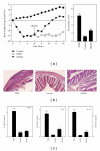Use of ghrelin as a treatment for inflammatory bowel disease: mechanistic considerations
- PMID: 21845198
- PMCID: PMC3154487
- DOI: 10.1155/2011/189242
Use of ghrelin as a treatment for inflammatory bowel disease: mechanistic considerations
Abstract
Inflammatory bowel diseases (IBD)-and in particular Crohn's disease-are immune-mediated processes that result in denuded intestinal mucosa and can produce decreased appetite, weight loss, and systemic inflammation. Current treatments include anti-inflammatory medications, immunomodulators, and feeding interventions. Ghrelin is an endogenous orexigenic hormone that directly stimulates growth hormone release, increases gut motility, and has cardiovascular and anti-inflammatory properties. Although ghrelin levels are elevated in active IBD, administration of ghrelin in most (but not all) animal models of colitis has produced improvements in disease activity and systemic inflammation. The mechanism for these effects is not known but may relate to decreased inflammation, increased motility, increased appetite, and increased colonic blood flow. Human trials have not been performed, however, and more research is clearly needed.
Figures


Similar articles
-
Development, validation and implementation of an in vitro model for the study of metabolic and immune function in normal and inflamed human colonic epithelium.Dan Med J. 2015 Jan;62(1):B4973. Dan Med J. 2015. PMID: 25557335 Review.
-
Orexigenic hormone ghrelin attenuates local and remote organ injury after intestinal ischemia-reperfusion.PLoS One. 2008 Apr 23;3(4):e2026. doi: 10.1371/journal.pone.0002026. PLoS One. 2008. PMID: 18431503 Free PMC article.
-
Therapeutic action of ghrelin in a mouse model of colitis.Gastroenterology. 2006 May;130(6):1707-20. doi: 10.1053/j.gastro.2006.01.041. Gastroenterology. 2006. PMID: 16697735
-
Crohn's disease affecting the small bowel is associated with reduced appetite and elevated levels of circulating gut peptides.Clin Nutr. 2013 Jun;32(3):404-11. doi: 10.1016/j.clnu.2012.08.024. Epub 2012 Sep 3. Clin Nutr. 2013. PMID: 22999064
-
Immunomodulatory effect of ghrelin in the intestinal mucosa.Neurogastroenterol Motil. 2015 Nov;27(11):1519-27. doi: 10.1111/nmo.12703. Neurogastroenterol Motil. 2015. PMID: 26503163 Review.
Cited by
-
VEN-120, a Recombinant Human Lactoferrin, Promotes a Regulatory T Cell [Treg] Phenotype and Drives Resolution of Inflammation in Distinct Murine Models of Inflammatory Bowel Disease.J Crohns Colitis. 2017 Sep 1;11(9):1101-1112. doi: 10.1093/ecco-jcc/jjx056. J Crohns Colitis. 2017. PMID: 28472424 Free PMC article.
-
The use of ghrelin and ghrelin receptor agonists as a treatment for animal models of disease: efficacy and mechanism.Curr Pharm Des. 2012;18(31):4779-99. doi: 10.2174/138161212803216951. Curr Pharm Des. 2012. PMID: 22632859 Free PMC article. Review.
-
Neuropeptide receptors as potential drug targets in the treatment of inflammatory conditions.Br J Clin Pharmacol. 2014 Jan;77(1):5-20. doi: 10.1111/bcp.12097. Br J Clin Pharmacol. 2014. PMID: 23432438 Free PMC article. Review.
-
Role of the Ghrelin System in Colitis and Hepatitis as Risk Factors for Inflammatory-Related Cancers.Int J Mol Sci. 2022 Sep 23;23(19):11188. doi: 10.3390/ijms231911188. Int J Mol Sci. 2022. PMID: 36232490 Free PMC article. Review.
-
Hormonal protection in acute pancreatitis by ghrelin, leptin and melatonin.World J Gastroenterol. 2014 Dec 7;20(45):16902-12. doi: 10.3748/wjg.v20.i45.16902. World J Gastroenterol. 2014. PMID: 25493003 Free PMC article. Review.
References
-
- Hanauer SB, Kornbluth AA, Messick J, Rubin DT, Sandborn WJ, Sands BE. Clinical scenarios in IBD: optimizing the use of conventional and biologic agents. Inflammatory Bowel Diseases. 2010;16(supplement 1):S1–S11. - PubMed
-
- Yamamoto T, Nakahigashi M, Umegae S, Matsumoto K. Enteral nutrition for the maintenance of remission in Crohn’s disease: a systematic review. European Journal of Gastroenterology and Hepatology. 2010;22(1):1–8. - PubMed
-
- Kojima M, Hosoda H, Date Y, Nakazato M, Matsuo H, Kangawa K. Ghrelin is a growth-hormone-releasing acylated peptide from stomach. Nature. 1999;402(6762):656–660. - PubMed
-
- Gonzalez-Rey E, Chorny A, Delgado M. Therapeutic action of ghrelin in a mouse model of colitis. Gastroenterology. 2006;130(6):1707–1720. - PubMed
Grants and funding
LinkOut - more resources
Full Text Sources
Other Literature Sources

